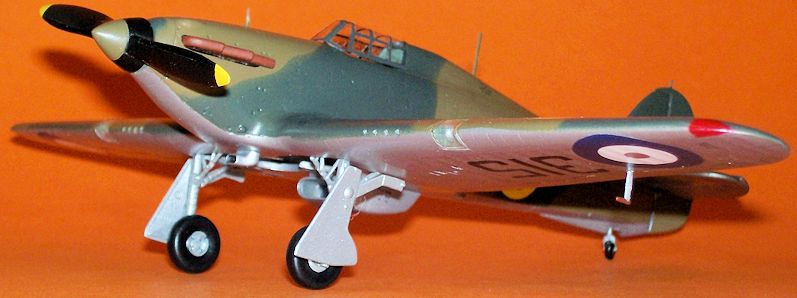
Classic Airframes 1/48 Hurricane I
| KIT #: | 460 |
| PRICE: | CAD 57.98 |
| DECALS: | Four options |
| REVIEWER: | Pablo Calcaterra |
| NOTES: | Eduard p.e., and Iliad decals used |

| HISTORY |
Canada was the first foreign user of the Hawker Hurricane.
Twenty ex-RAF planes were purchased and shipped to Canada early 1939. After
negotiations a further plane (L1848) was sent by Hawker Aircraft to Canadian Car
& Foundry along with complete microfilmed plans for production of MkIs to be
powered by Merlin III engines shipped from England to Canada.
These Canadian planes were fabric covered wings and most of them had two bladed propellers. In Canadian service the planes were given 3 digits serial numbers. A complete detail of the planes can be followed here.
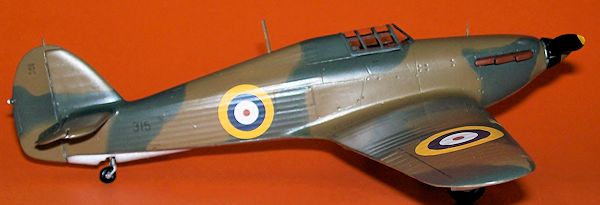 No1 (F) RCAF Squadron replaced their obsolete Siskin
with Hurricanes between February and March 1939 at RCAF Station Sea Island, BC.
Then the planes were moved to the original base for this squadron which was
Calgary, AB in June 1939.
Moved with
squadron detachment to RCAF Station Dartmouth, NS, 5 November 1939.
No1 (F) RCAF Squadron replaced their obsolete Siskin
with Hurricanes between February and March 1939 at RCAF Station Sea Island, BC.
Then the planes were moved to the original base for this squadron which was
Calgary, AB in June 1939.
Moved with
squadron detachment to RCAF Station Dartmouth, NS, 5 November 1939.
By the moment war broke two planes (312 and 317) had been
lost in accidents. The Squadron then moved to St. Hubert, QC, near Montreal.
Three more planes were added to the flight line, one of which was at the
Canadian National Exhibition(sn#329) in Toronto on static display. Their
Squadron Leader was E. G. Fullerton.
In November the Squadron flew from St. Hubert to Dartmouth,
NS (opposite to Halifax) in a three leg trip. It was there joined in May 1940 by
the pilots of 115 Sqn (an Auxiliary weekend squadron) that had predominantly
Montrealers. Some members of 8,10 and11 Bomber Reconnaissance squadron also
joined 1(F) Sqn there. On November 1st Ernie McNab became the
Squadron Leader replacing Fullerton.
On November 20th Hurricane 329 crashed
killing F/O D.R Anderson. Escort duties started on December 22nd.
On May 22nd the Squadron was informed that they
were to be posted to the UK and the planes started to be crated. The idea was
that they were to support the Canadian Army units that were to fight in Europe
but the speed of the Blitzkrieg prevented these units from being involved in
combat.
On June 8th 1940 the Squadron members boarded
Duchess of Atholl in Halifax and the trip started on the 11th. On the
20th the ship arrived at Liverpool. The following day the Squadron
arrived in RAF
Middle Wallop.
 Air chief Marshal Sir Hugh Dowding paid a visit to 1 (F) Sqn
on June 25th. When he learnt that their Hurricanes were fabric wing
and in fact, almost obsolete, he ordered their immediate replacement by more
modern Hurricanes. This new Hurricanes were received on June 30th.
Thus ended the RCAF story of these original fabric wing Hurricanes which were
relegated to training units (OTUs) except for 323 that was sent to 615 Sqn and
was shot down on November 6th near Sevenoaks in Kent killing his
pilot Sgt. Jack Hammerton.
Air chief Marshal Sir Hugh Dowding paid a visit to 1 (F) Sqn
on June 25th. When he learnt that their Hurricanes were fabric wing
and in fact, almost obsolete, he ordered their immediate replacement by more
modern Hurricanes. This new Hurricanes were received on June 30th.
Thus ended the RCAF story of these original fabric wing Hurricanes which were
relegated to training units (OTUs) except for 323 that was sent to 615 Sqn and
was shot down on November 6th near Sevenoaks in Kent killing his
pilot Sgt. Jack Hammerton.
The Squadron was moved to Croydon in July and the
letters YO were assigned. While being attached to No 111 Sqn in order to gain
operational experience, Sqn Ldr McNab shot a Dornier 17 on August 11th.
1 (F) Sqn RCAF entered the Battle of Britain on August 24th
(in a tragic fashion shooting down two RAF Blenheims) based on Northolt but that
is a different story. By the moment they were pulled out of the Battle to rest
in Scotland
they had accounted for
30 enemy planes, probably destroyed 8 and damaged 35. Three pilots had been
killed (F/O Edwards, F/O Smither and F/O Peterson) and ten others wounded. 19
Hurricanes were shot down or crash landed. Sqn. Ldr. McNab, F/L McGregor and F/O
Dal Russell received the DFC.
In regards to 315 (subject of this article) it was taken on
charge by the RCAF on April 15th 1939 at Station Sea Island. Moved to
Calgary, Dartmouth and was coded YO-M when the squadron was based in the UK.
After it was returned to the RAF in June it was operated by No. 6 OTU till early
1941.
| THE KIT |
Review of the kit can be found here.
| CONSTRUCTION |
The cockpit has a good representation of the tubular
structure. After cleaning the parts (removing some flash here and there)
construction went very well except for some fiddly parts. Wear of the cockpit
area 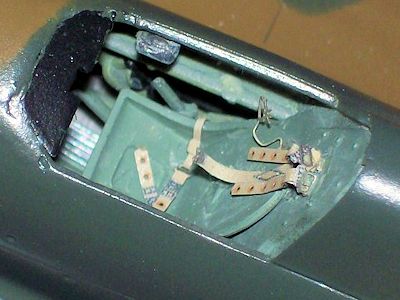 was created by
drybrushing silver paint in the most exposed areas. Seat
belts (prepainted) from Eduard completed the area.
was created by
drybrushing silver paint in the most exposed areas. Seat
belts (prepainted) from Eduard completed the area.
There is no plastic to hold the exhausts in place (the area
is just a long hole) so I glued plasticard that I painted in black thus creating
a fixing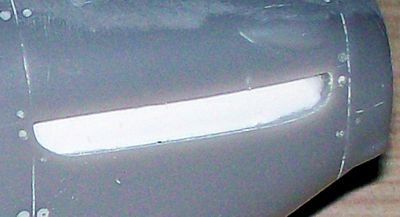 point.
point.
Another contentious area is the engine face (part 30) that
was too large for the fuselage halves. After lots of trimming and checking
pictures I managed to make it fit (I was tempted to leave it aside…it is
practically impossible to see it behind the propeller).
The Canadian planes had the ventral fin and this one (that
had some injection problems) was glued in place. Some filler was required to
cover the holes and the union to the fuselage. The tropical vents on the sides
of the cockpit were sanded.
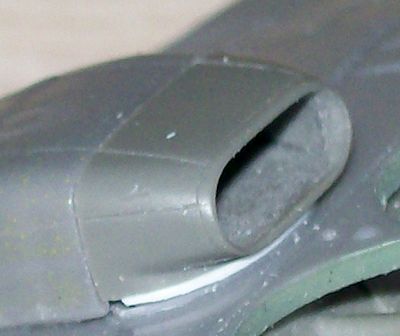 Late production rudder is slightly taller than the tail
assembly so I had to sand it slightly while keeping the contour.
Late production rudder is slightly taller than the tail
assembly so I had to sand it slightly while keeping the contour.
Wings were attached with practically no problem after the
wheel well was sanded to make it fit (it is a beautiful resin part). I had
previously cut out the landing lights and installed the resin ones. I did not
bother installing the resin machine guns.
The installation of the radiator bath was tricky as the resin
part (R1) is too short. After c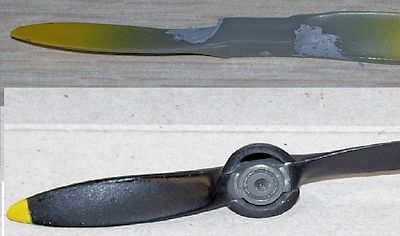 hecking some references and how other modelers
had overcome the problem I decided to add a piece of plasticard to have a flush
union with part 29 (plastic)
hecking some references and how other modelers
had overcome the problem I decided to add a piece of plasticard to have a flush
union with part 29 (plastic)
Tail planes were attached and he horizontal surfaces glued in
a dropped position.
The Watts Z-38 propeller has some sink holes that
required a considerable amount of putty.
| COLORS & MARKINGS |
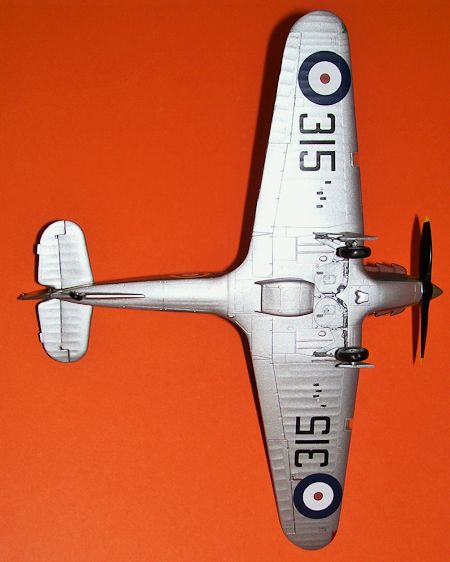 I gave the plane a coat of light gray to check for
imperfections and also to give a better surface for the MM Acryl paints to
adhere.
I gave the plane a coat of light gray to check for
imperfections and also to give a better surface for the MM Acryl paints to
adhere.
Undersurfaces and wheel wells were painted with MM Acryl
Aluminum. Once masked the tip of the propeller and the rest of the plane were
given a coat of RAF Dark Earth. Further masking with paper and rolls of Blue Tac
allowed me to paint the rest of the plane with RAF Dark Green.
Propeller boss and blades were painted in black.
Interior green was used for the structure holding the landing lights.
The landing light covers (C3 and C4) had been trimmed to make
them fit, masked and painted.
Once ready I highlighted the moving surfaces of the wings
using a very sharp black pencil.
The kit was given some coats of Future to get it ready for
the decals.
Fantastic decals manufactured by Iliad. Great register, ink density and instructions. No problems whatsoever.
| FINAL CONSTRUCTION |
I glued the landing gear. The entire plane was given a coat
of satin varnish. The ring and bead sight were glued, along with the exhausts,
antenna, tail wheel, pitot tube. In pictures it is clear that the union of the
propeller to the fuselage is not flush but there is a gap and a round structure
attached behind the propeller
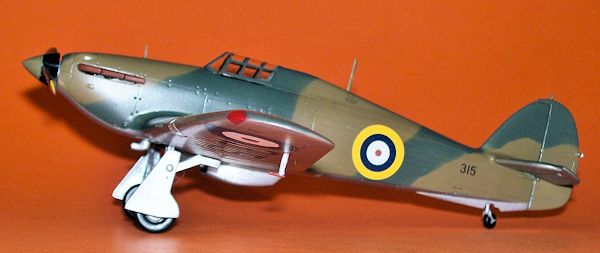 hub. I took a round piece of plastic from the
spares box, sanded it down (it was too thick), painted it in aluminum and
attached it to the propeller which in turn was glued to the engine face.
hub. I took a round piece of plastic from the
spares box, sanded it down (it was too thick), painted it in aluminum and
attached it to the propeller which in turn was glued to the engine face.
I painted the navigation lights (white for the rudder, red
and green for the wing tips). The glass part of the landing lights was glued
using cyano.
I had to cut and trim and test fit many times the windshield
/ Canopy (part C1) until I achieved a decent (but not perfect) fit. As the
canopy is closed the step to climb into the cockpit was left retracted (31).
With this the model was completed.
| CONCLUSIONS |
Nice kit, needs some work to improve the fit. I have not
found too many early Canadian Hurricanes in the Internet (not even from 1 (F)
Sqn during the Battle of Britain in fact!) So I hope this model covers a little
bit of that gap.
| REFERENCES |
·
High Blue Battle (Dave McIntosh)
·
Hawker Hurricane (Richard Franks - SAM Editions)
·
Thanks to Debbie Brentnell - Bibliographic Searcher |
Orientation Services - Information and Research Services Division at the Library
and Archives Canada for pictures of early Hurricanes in Canadian service.
·
Canadian Military Aircraft
Serial Numbers website
March 2013
If you would like your product reviewed fairly and fairly quickly, please contact the editor or see other details in the Note to Contributors.